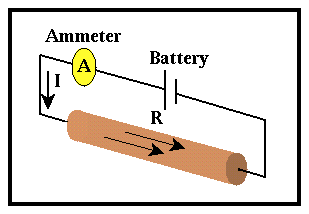 In 1827, Georg Ohm defined an
empirical relationship between the current flowing through a wire and the voltage potential required to
drive that current.*
In 1827, Georg Ohm defined an
empirical relationship between the current flowing through a wire and the voltage potential required to
drive that current.*
 In 1827, Georg Ohm defined an
empirical relationship between the current flowing through a wire and the voltage potential required to
drive that current.*
In 1827, Georg Ohm defined an
empirical relationship between the current flowing through a wire and the voltage potential required to
drive that current.*

Ohm found that the current, I, was proportional to the voltage, V, for a broad class of materials that we now refer to as ohmic materials. The constant of proportionality is called the resistance of the material and has the units of voltage (volts) over current (amperes), or ohms.

In principle, it is relatively simple to measure the resistance of a strand of wire. Connect a battery to a wire of known voltage and then measure the current flowing through the wire. The voltage divided by the current yields the resistance of the wire. In essence, this is how your multimeter measures resistance. In making this measurement, however, we must ask two crucial questions.
